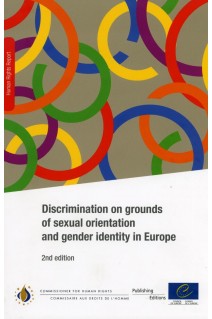



Many people in Europe are stigmatised because of their sexual orientation or gender identity and cannot fully enjoy their universal human rights. Some of them are victims of violence, others have fled to Europe from countries where they risk being persecuted. Organisations representing lesbian, gay, bisexual and transgender (LGBT) persons have been denied registration or banned from organising peaceful meetings in some states in Europe. Too few politicians have taken a firm stand against homophobic and transphobic expressions, discrimination and violence.This report presents the results of the largest socio-legal study ever carried out on discrimination on grounds of sexual orientation and gender identity in the 47 member states of the Council of Europe. Six thematic chapters give a broad overview of the human rights situation of LGBT persons and recommendations are provided for developing and implementing effective measures to address discrimination.The report is intended as a tool for dialogue with authorities and other stakeholders. It constitutes a baseline study for further action in both legislative and policy fields to ensure that all LGBT people can effectively exercise their human rights.
Foreword
Summary
Recommendations
Introduction
1. Attitudes and perceptions
1.1. Lesbian, gay, bisexual and transgender persons
1.2. Criminalisation and medical classifications
1.3. Attitudes towards LGBT persons
1.4. Perceptions of the nation, religion and traditional values
1.5. Perceptions of LGBT persons' visibility and use of public space
1.6. Media
2. Legal standards and their implementation
2.1. Introduction
2.2. International and European standards
2.3. National standards
2.4. National structures for promoting equality
2.5. National policy initiatives
3. Protection: violence and asylum
3.1. Introduction
3.2. Violence against LGBT persons
3.3. Asylum on the grounds of sexual orientation and gender identity
4. Participation: freedoms of assembly, expression and association
4.1. Introduction
4.2. International and European standards
4.3. Situation in the member states
5. Privacy: gender recognition and family life
5.1. Introduction
5.2. Recognition of transgender persons' new gender and name
5.3. The right to marry and legally contract a partnership
5.4. Parenting and children
6. Access to health care, education and employment
6.1. Introduction
6.2. Health
6.3. Education
6.4. Employment
Conclusions
Appendix: Terms and concepts
Download an extract (1000)

Many people in Europe are stigmatised because of their sexual orientation or gender identity and cannot fully enjoy their universal human rights. Some of them are victims of violence, others have fled to Europe from countries where they risk being persecuted. Organisations representing lesbian, gay, bisexual and transgender (LGBT) persons have been denied registration or banned from organising peaceful meetings in some states in Europe. Too few politicians have taken a firm stand against homophobic and transphobic expressions, discrimination and violence.This report presents the results of the largest socio-legal study ever carried out on discrimination on grounds of sexual orientation and gender identity in the 47 member states of the Council of Europe. Six thematic chapters give a broad overview of the human rights situation of LGBT persons and recommendations are provided for developing and implementing effective measures to address discrimination.The report is intended as a tool for dialogue with authorities and other stakeholders. It constitutes a baseline study for further action in both legislative and policy fields to ensure that all LGBT people can effectively exercise their human rights.
Please note that in accordance with our terms & conditions, PDF/epubs may only be purchased by private individuals.
